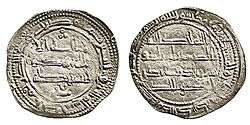Abd al-Rahman II
Abd ar-Rahman II (Arabic: عبد الرحمن الأوسط) (792–852) was the fourth Umayyad Emir of Córdoba in the Al-Andalus Iberia from 822 until his death.[1]
| Abd ar-Rahman II (عبد الرحمن الأوسط) | |
|---|---|
 Silver dirham coined during the reign of Abd ar-Rahman II. | |
| 4th Emir of Córdoba | |
| Reign | 21 May 822–852 |
| Predecessor | al-Hakam I |
| Successor | Muhammad I |
| Born | 792 Toledo |
| Died | 852 (aged 59–60) Córdoba |
| Father | Al-Hakam I |
| Mother | Halawah |
Biography

Abd ar-Rahman II was born in Toledo, the son of Emir Al-Hakam I. In his youth he took part in the so-called "massacre of the ditch", when from 700 to 5,000 people came to pay homage to the princes who were killed by order of Al-Hakam.
He succeeded his father as Emir of Córdoba in 822 and engaged in nearly continuous warfare against Alfonso II of Asturias, whose southward advance he halted (822–842). In 825, he had a new city, Murcia, built, and proceeded to settle it with Arab loyalists to ensure stability. In 835, he confronted rebellious citizens of Mérida by having a large internal fortress built; again in 837, he suppressed a revolt of Christians and Jews in Toledo via the same measures.[2] He issued a decree by which the Christians were forbidden to seek martyrdom, and he had a Christian synod held to forbid martyrdom.
In 844, Abd ar-Rahman repulsed an assault by Vikings who had disembarked in Cádiz, conquered Seville (with the exception of its citadel) and attacked Córdoba itself. Thereafter he constructed a fleet and naval arsenal at Seville to repel future raids.
He responded to William of Septimania's requests of assistance in his struggle against Charles the Bald's nominations.
Abd ar-Rahman was famous for his public building program in Córdoba where he died in 852. He made additions to the Mosque–Cathedral of Córdoba.[1] A vigorous and effective frontier warrior, he was also well known as a patron of the arts.[3] He was also involved in the execution of the "Martyrs of Córdoba".[4]
References
- "'Abd ar-Rahman II". Encyclopædia Britannica. I: A-Ak - Bayes (15th ed.). Chicago, IL: Encyclopædia Britannica, Inc. 2010. pp. 17. ISBN 978-1-59339-837-8.
- The Inheritance of Rome, Chris Wickham, Penguin Books Ltd. 2009, ISBN 978-0-670-02098-0. p. 341.
- Thorne, John (1984). Chambers biographical dictionary. Edinburgh: Chambers. ISBN 0-550-18022-2.
- Chisholm, Hugh, ed. (1911). . Encyclopædia Britannica. 1 (11th ed.). Cambridge University Press. p. 31.
Abd al-Rahman II Banu Umayyah Cadet branch of the Banu Quraish Died: 852 | ||
| Preceded by al-Hakam I |
Emir of Córdoba 822–852 |
Succeeded by Muhammad I |
